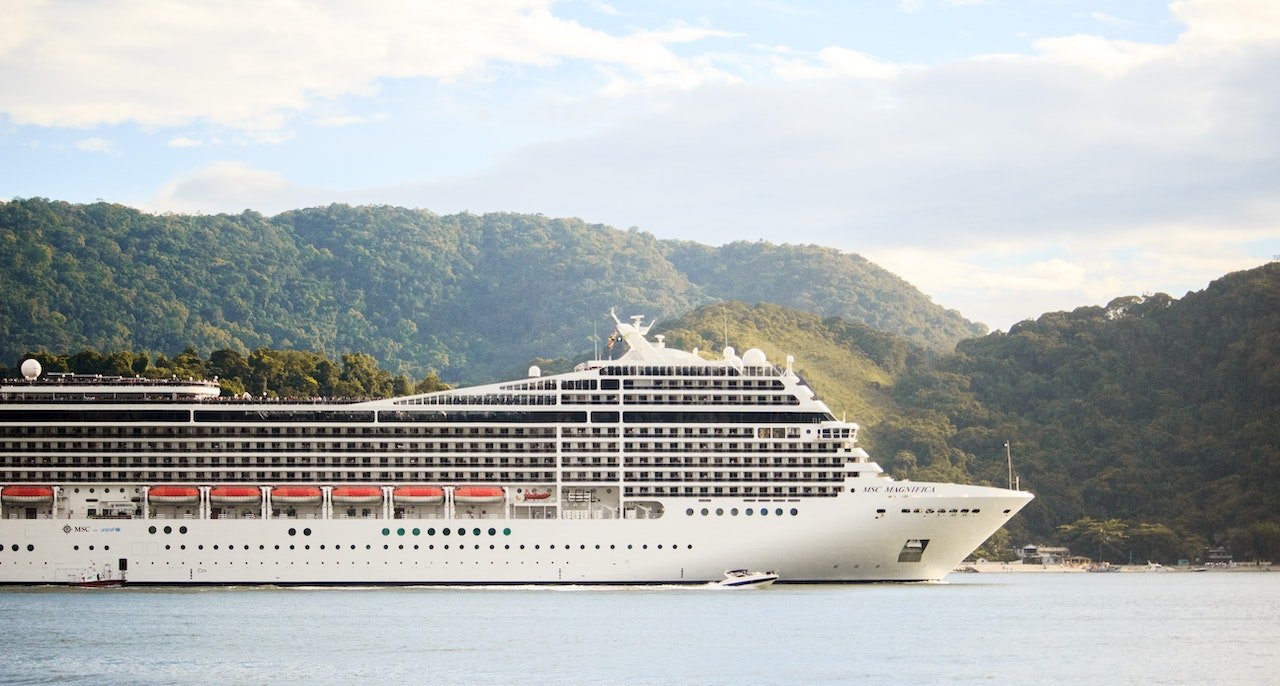Mega cruise ships are a strange artifact of our civilization, armed with dangling water slides and umbrellas, they are designed to awe customers into having a nice time, but it is not sustainable.
A medium-sized cruise ship spews greenhouse gas emissions equivalent to 12,000 cars.
The industry has been dogged by bad PR, from routine dumping of toxic sludge to increasingly organized outrage from communities tired of hordes of tourists getting dumped at their docks.
A Norwegian cruise company, Hurtigruten, has built its last fossil fuel-powered ship.
On June 7, the company evinced new details about the cruise expected to be ready by 2030. The details include the technologies it’s testing in pursuit of the world’s first zero-emission cruise ship and renderings of what the boat might look like.[1]
Instead of towering over the ocean, the ship clings close to the water with retractable sails that double as solar panels. It runs on batteries instead of the thick, sticky fuel oil that powers most ships.
Daniel Skjeldam, CEO of Hurtigruten, is one of few CEOs who doesn’t shy away from the conflict between the pursuit of more and the limits of the earth’s biosphere. He is a strong advocate for environmental protection.
“I think it’s sheer wrong to build bigger and bigger and bigger cruise ships,” Skjeldam says. The average cruise ship has around 3,000 passengers, but cruise companies have been investing in ever-bigger liners. “7,000 [passengers], 8,000, 9,000,” Skjeldam says. “It’s just wrong.”
Skjeldam, then commercial director at Norwegian Air Shuttle, thought he could turn Hurtigruten (the name means “Express Route” in English) around. He was appointed CEO in October 2012 and was on a Hurtigruten ship sailing past the Svalbard archipelago, home to the world’s northernmost inhabited town.
The experience was eye-opening, and under his leadership, the company began investing in sustainability.
In 2016, Hurtigruten began outfitting its ships to use power from the grid while tied up in port instead of burning their fuel.
This year, the company ordered the world’s first hybrid-power cruise ships. It started offering cruises on its first, the MS Roald Amundsen, which has about 20% lower emissions than a similarly sized conventional ship.
Both customers have driven the desire for more sustainable travel and employee demands.
Hurtigruten is the largest employer in Longyearbyen, Svalbard, aiming for carbon-neutral operations by 2040 and to cut all scope three emissions by 2050.
However, progress has been slow due to energy prices, making it more expensive to buy low-carbon biofuels.
Batteries vs. Biofuels in Sea Cruising
Hurtigruten’s work may prove worthy technologies for the cruise industry, but the central idea of using a big battery may be impossible for bigger ships.
Sails can help, but they can’t do more than provide an energy boost.
Biofuels or synthetic fuels produced using renewable energy have their drawbacks. Methanol, made from renewable energy and CO2, is a good choice.
Still, it requires obtaining CO2 from a limited global biomass supply or using huge amounts of renewable energy to pull CO2 from the atmosphere.
Ammonia is another option, but it wouldn’t work for passenger ships. Hydrogen is also tricky to work with, as it leaks easily and must be supercooled to reach high enough densities to transport.
Four companies—Carnival, Royal Caribbean, Norwegian Cruise Lines, and MSC—control the lion’s cruise market share. They have made positive moves, such as investing in ships running on methanol.
Still, their current environmental plans primarily hinge on using liquified natural gas (LNG) in the newest generation of ships. LNG has about 30% lower carbon dioxide emissions than using heavy fuel oil.
Natural gas, also known as methane, is a powerful greenhouse gas with a warming potential over 80 times greater than CO2 over a 20-year timescale.
When asked about using LNG on its vessels, Carnival pointed to the company’s “long-term aspirations to achieve net carbon-neutral ship operations by 2050.”
MSC Cruises and Royal Caribbean did not respond to requests for comment. Carnival is piloting green technologies such as LNG, biofuels, fuel cells, and large battery storage systems.
Currently, there is little regulation to limit greenhouse gasses from shipping, the International Maritime Organization (IMO) of the United Nations has the authority to force deep, sustained emissions cuts but is heavily influenced by industry interests.
The Cruise Lines International Association (CLIA) has yet to be able to help strengthen emissions standards in ongoing IMO talks on greenhouse gas reductions.
“Anything that they can do to try and make the math work in their favor and to not have to do anything is what they’re trying to do at the International Maritime Organization,” says Comer.
“They set targets that already include loopholes for them, and then they fight against climate regulations in foreign policy forums, and then once the regulations are agreed, they start fighting for exemptions and adjustment factors and special treatment. And oftentimes they get it.”
References
- Kyla Mandel, and Elijah Wolfson, ‘Can Cruises Become Climate Change Friendly?’, TIME, 13 June 2023, https://time.com/6285915/cruise-industry-climate-action-emissions-passengers/[↩]





